Similar Posts
Sharing our teaching method, I invite fellow iconographers to share their views on teaching, as only by approaching this subject from several sides can we foster a new generation of iconographers who will be better than us.
The teaching method my wife Olga Shalamova and I now use took its shape gradually. In Italy in 1994 I started as an interpreter and assistant to my dad. His method was mainly built on two key aspects: sharing his knowledge in theology, history of iconography and art and showing the way he worked. During the courses he would always paint one or two icons, demonstrating his method. I remember him speaking about the core theological concepts of iconography and what makes it different from religious painting. Mornings would begin with a prayer or liturgy, and then continue as a true workshop, where everybody was working creatively and asking advice from each other and from the instructor. In addition to that, several times during the day my dad was personally helping students with their work so that they could bring home their finished icons. I clearly remember my dad during and especially after the courses. These were times of such hard work and extreme concentration, so that by the end of a course (which could last up to 12 days) he was totally drained and completely exhausted. We spoke about this many times. Although he saw that this method was not ideal, he did not see how it could be changed for the better.
Helping students with their icons, he was actually pulling and pushing them through a curriculum they would be unable to perform on their own. Keeping in mind that each student was hoping to bring home a finished product, he did his best in helping everyone to obtain a decent final result at the cost of enormous effort.
From testimonies of both my dad and his apprentices I know that this approach was stressful for all. Yet, there seemed to be no alternative even though we knew that other iconographers were teaching differently. Many of them were providing students with ready-made linear drawings. This helped to reduce the amount of work but my dad insisted that only icons which start with individual drawings can be authentic and work as convincing visual sermons.
When I was first invited to teach in Italy in 2004, I followed my dad’s method. Just like him, I was teaching students to start every icon with drawing. I was also doing my best: choosing models and helping workshop participants step by step to carry on their work. The whole workshop time was dedicated to actually performing the working process I would normally have at home; the only difference was that at the workshop I had no time for research. Just like other iconography teachers, I was helping our students to finish their icons by the end of a 5-day course. My wife Olga helped me with this curriculum for several years, but at a certain point we thought that something was really wrong with this feeling of deep exhaustion and helplessness during and after each workshop. We realized that we were at the same time teachers who shared their knowledge, and tutors who required their students to show a Chef-d’oeuvre (an artful final image in the traditional meaning of the French word).
Something was not right as we knew from our personal work & study experience. After a learning process, one can feel fatigued but not helpless, as if something was completely off.
It was sometime in 2018 when we decided to make an experimental workshop. One where we would not promise our potential students that they would be fully finishing their icons. We went even further – we said that none of them were going to work on gessoed board, but only on paper. We planned it for a location, where we had taught several workshops, so we thought it would be a good chance to make a change with a totally new program for people who knew us.
Iconography Workshop Student learning how to draw a frontal face. Melbourne, Australia. 2018. Additional photos
First, we were really afraid, as it was a total shift of focus, and it could be a total failure. In making the new program we stopped describing our workshops as events, where you were supposed to “produce” and bring home a nice and shiny gilded icon. Elaborating our new approach, we decided to give the most time and energy to the actual learning process versus teaching how to accurately execute particular steps on the gessoed board. In the description of the workshop, we defined the new goals and suggested new practices. We promised that instead of bringing home an icon, partly produced by the student and partly by the instructor, our student would be coming home with a pile of drawings, which he or she will have executed with very little or no instructors’ help.
As I mentioned above, we proposed this to the students who knew us, and everything went well. From that time on we began varying the amount of studies per workshop, always keeping the main focus on learning. Now we spend the first 2.5 days making drawings and sketches as a preparation for an actual icon, which we now paint in the last 2.5 days. We see that this experience works best. Students have time to learn lots of skills with no pressure of making a wrong move, and when they actually start working on their own icon, they are confident and know what they are doing.
The main decision was to stop teaching techniques and to start teaching a method and structure, which can always be adjusted for individual conditions and needs.
It was hard to do from scratch, but we began with the concept that even the most unusual icons and frescoes, as well as the most non-classical book illustrations (like stunning ones from Armenia or Lindisfarne) are originally based on human anatomy. Agreeing on that, we assume that in different historical periods, in different lands, and in different circumstances, artists’ purposes were different. From here we made the next step, knowing that there are certain common characteristics, which we find in the vast majority of liturgical artworks. If we have seen them for almost two thousand years, and it looks like they are not accidental, then our job as iconographers (and iconography instructors), is to teach how to produce images with these characteristics – rather than trying to teach specific techniques or skills. Using this method, we compare every image with what it could look like if rendered according to classical human anatomy, analyzing what purposes the changes and applied means were meant to serve.
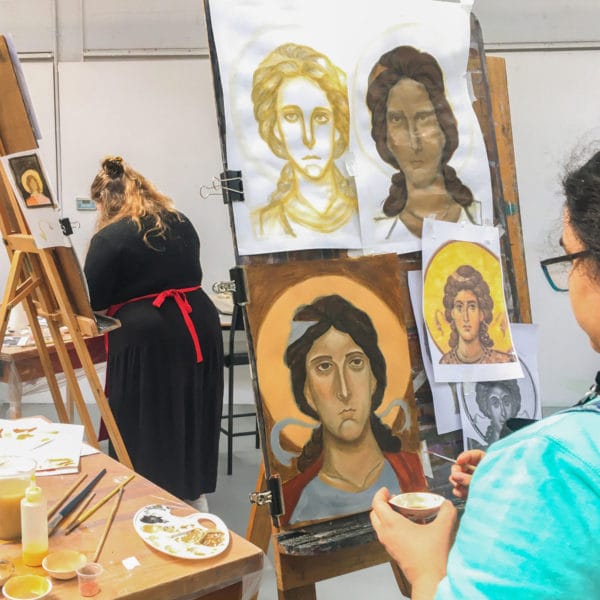
Iconography Workshop Student keeps results of different tasks attached to a panel. Melbourne, Australia, 20
Apart from endless learning opportunities, this approach to medieval Christian art helps to restrain from quick judgements and close-minded conclusions. We actually did not invent this approach. I used the method my dad tried to use on me, plus we borrowed some teaching principles we were introduced to while learning at the Academy of Fine Arts in Saint Petersburg. At our Alma Mater every aspect of teaching had its own reason and answered a specific question. This is why we continuously adjust our teaching method, trying to include not only the practical side, but also theology and general theory. We discovered that to make a workshop more efficient we should expose our students to as many different learning activities as we can – because everybody learns differently. Yet, introducing our students to a number of disciplines, we found that the most difficult part is defining a way to teach theoretical subjects such as theology and theory of iconography to those who are or want to be visual artists. I do not mean to say that all artists have difficulty memorizing abstract concepts. It’s because for iconographers, theology of the icon is not just a “theory” – it’s one of the reasons why they chose this vocation. I can hardly find another sphere of human activity where the theory of the activity is itself of such a crucial importance – except maybe, for pedagogy, where the theory of teaching actually lies in the core of teaching. Overall, it’s really hard to imagine how to teach a form of artistic activity which is informed by theology, rooted deeply in tradition, and yet, to function properly, needs to involve creativity.
It sounds undoable, however, it’s very much like learning in any academic environment. Each professor is sharing his or her own vision, and each subject adds to the other ones and to the whole. The academic environment is the place where people ask questions – not only do they learn what they are supposed to, but also the value of research. And I think it’s probably the most missed feature of today’s iconography education: the discussion and criteria for what iconography is and what it should be, considering the context of the XXI century.
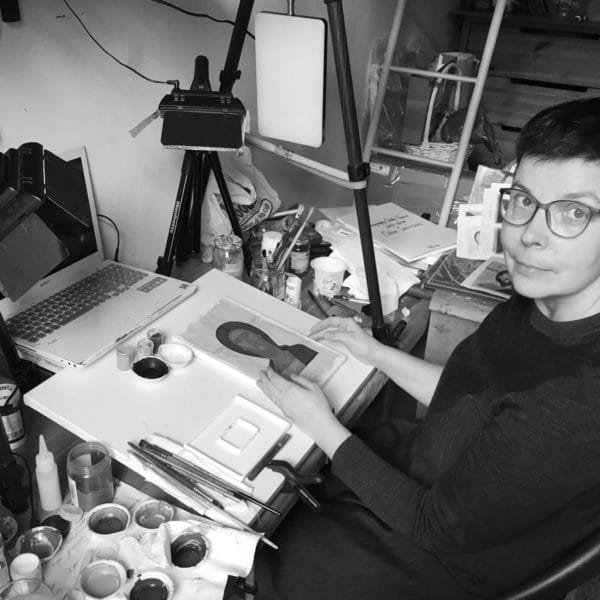
Olga Shalamova in process of filming tutorials for our Iconography Study Group Program. 2024
It seems to me that this is the kind and type of questions and education Father Silouan was talking about in his article. I totally agree with you, Father Silouan. A serious, multidisciplinary education in iconography is now highly requested. After the first interest in iconography has been spreading in different countries for at least some decades, now is the time for a more complex approach, allowing clergy, iconographers and lay people to deepen their knowledge in our field. To see images in the church not only because they are connected with their models, or because they illustrate biblical events, but because they visually communicate their faith in God.
Talking to colleagues in different countries, I realised that one of the most important shifts in iconography education of our time has already happened. It was during Covid times, when we all were forced to dive deeper into technology – even spheres where it seemed totally unsuitable are now open for technology. Being home bound suggested opening new forms of communication, but also new forms of teaching, especially anything related to drawing. It appears that for many subjects like drawing or even for certain lectures it’s better to have enough time for thorough explanations and for individual training. In this case video tutorials work really well, with in-person tutoring there is never enough time to practice drawing, while with online presentations one can watch them as many times as it takes. Besides discussing and fixing students’ mistakes in a real class setting , you have a very limited time frame. In a class you feel that everybody is working and moving forward in their work, so you can only fix a certain step once – otherwise someone may be too far behind. For some simple subjects it’s okay, but for more complex issues it’s just not enough time as we all have to move on. So, this is the advantage of teaching online. Having a week or two-week time frame for a certain assignment students can work on their tasks at their own pace, and as instructors we have an opportunity to suggest our corrections individually, with no hurry and no pressure of other students falling behind in their studies. Besides, just like in a real class, but even better, students in Google Classroom can see the works of their fellow classmates and read our comments, steadily learning from each other’s mistakes. It’s so unbelievably rewarding when you read comments they write thanking us for our corrections.

One of the Study Group assignments: finalizing the drawing with addition of yellow ocher.
Yet, for those who think that teaching online is easy, I will share a bit of our process to show what is behind the final result.
Have you ever tried to look at your work process from above – as if you were watching someone else’s workflow filmed with a hidden camera? That’s what it is like at first glance, but it’s much more exciting.
Watching other artists’ tutorials, we found out that actually teaching something to someone is very different than just showing how you actually work. So, when we started filming our courses, it became clear that the most laborious part was behind the scenes.
Time became the main currency – you spend more of your time on your side so that your students can spend less. It seemed evident, but we never thought of it: for every good demonstration one needs to write a detailed scenario. We need to describe every action, technique and subject in a crystal clear manner, so that anyone can have a very clear idea of it. To make your lesson become a real hands-on tutorial one has to think, try, retry and re-write the scenario several times before it can really be used as a lesson. Nobody told us that to prepare a half hour video tutorial we will need several weeks or even months for filming, but we now know how it works. And the best thing is that we and our students love the results.
Yet, after filming several courses, which covered a a specific segment of iconography (how to draw slightly asymmetrical faces, how to draw blessing gestures and what is the difference between them, and other topics), we discovered that making separate courses was not enough. A summary of nicely crafted details does not make either a house or an icon, so last year we introduced a Study Group program.
This program allows us to gather all the knowledge together, learn what was missing and paint an icon. We began preparing and filming this course in August 2023, doing our best to fill every second of our video lessons with detailed hands-on demonstrations. It was actually a very challenging task – to lead people through all the complexity of the work process. We were showing our students how to prepare the first sketches, how to scale them up adding details, how to work with several models and how to make a synthesis. It was an interesting experience to see people facing real challenges and solving real tasks.
This program is ending at the middle of May, and from the responses of our students it sounds like they also had a good experience, so we will launch it again in September.
Teaching iconography means trying to learn the system of values of our predecessors, although for many of us it is also a call for creativity in church. In a certain way it’s like learning “Effective Writing”: we spend months or years drowning in the world of world literature, and at the end of the day it’s teaching us how to write for people of our time with our own words.
Here is what an ideal iconography teaching process looks like for me: It’s inspiring to reveal the treasures of the past for our students, and a joy to see how they start using the keys to open the doors of knowledge. There is a sense of accomplishment in observing our students learning to appreciate our common treasures and use the means that traditional iconography has to offer.
What are these means? How can we learn to write or paint icons without worrying about taking the wrong road? There is only one answer to that, as I mentioned above – to follow a learning method based on interdisciplinary studies and values, where each new aspect or subject helps to reveal what you already know better. It may sound confusing and complicated, but only by choosing an adjustable and transparent learning curriculum can we let contemporary iconography evolve without losing its core.
Philip Davydov
April 2024
This text was kindly reviewed and edited by Valentina Knap and Andrew Gould.
If you enjoyed this article, please use the PayPal button below to donate to support the work of the Orthodox Arts Journal. The costs to maintain the website are considerable.

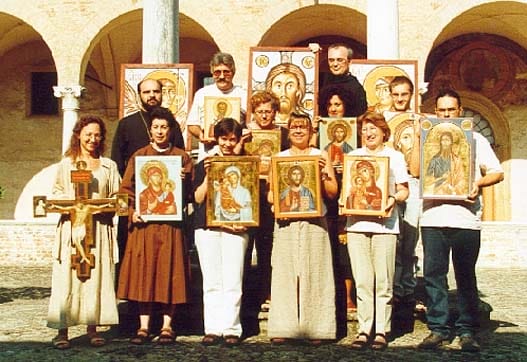
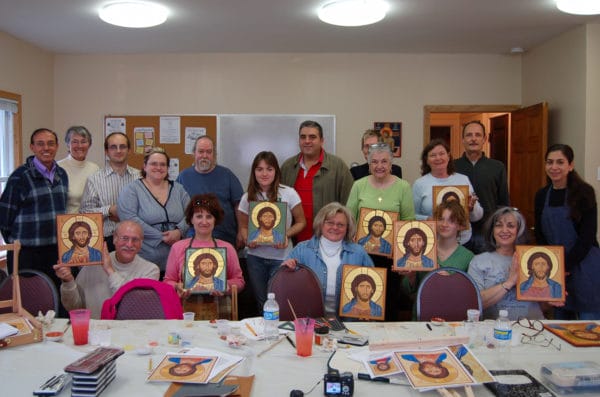
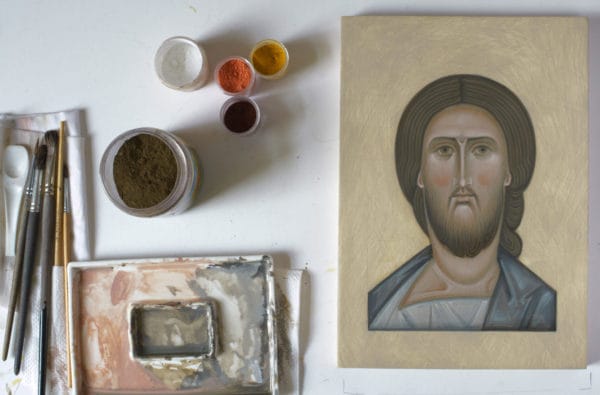
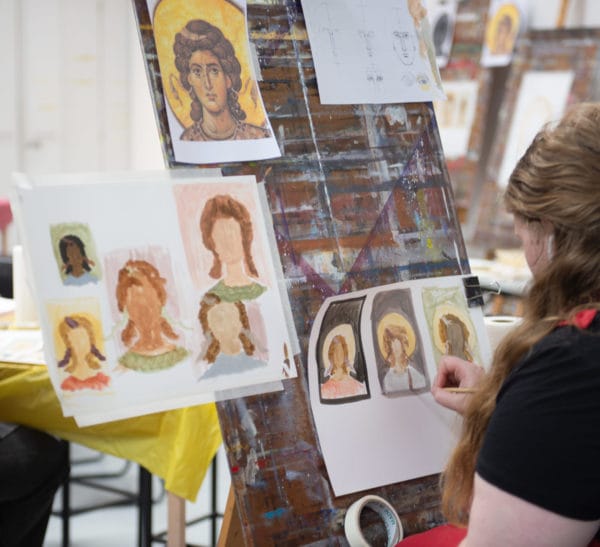
An excellent article, thank you. I began learning about icons by doing once a year, week long workshops eight years ago. During the pandemic I turned to an online programme, which I found a much richer experience, steeped in technique, theology and liturgy. As a Masters graduate in Education, with a teaching diploma, what really enhanced the experience for me was the ability of the teacher to teach. I have been fortunate to learn from some of the best in the field but if they did not know how to teach (androgogy) the experience was very frustrating.
Thank you, Philip and Olga for sharing your thoughts and ideas on teaching icon writing. May God continue to bless the work of your hands.
Christine Hales. Iconographer
You have created a very thoughtful, realistic, and creative approach to teaching iconography. Thank you for this article and the reference to your courses. Very impressive!
Спасибо вам, Филипп и Ольга, за Вашу работу. Вы идёте по серединному пути, где важно: не копировать, а анализировать, не использовать чужие находки, а понимать как находить свои решения, но не от ветра в голове ( я так вижу), а через понимание того, что делаешь. Это по-настоящему живой процесс!
Ho letto con grande interesse l’articolo in cui trovo pienamente. L’insegnamento attuale è diventato estremamente meccanico e privo di ogni vitalità. Erroneamente si è creduto che conservando la forma, si conservasse automaticamente il contenuto e si è da sempre confuso lo stile con il linguaggio. Questi sono stati gli errori grossolani in cui siamo caduti. Abbiamo solo risposto ad una domanda : ”come si dipinge un’icona?” E la risposta non è sempre stata all’altezza. E ancora non lo è. Abbiamo coperto la nostra ignoranza tecnica e anatomica (nel senso di non sapere mettere in relazione proporzionata le diverse parti del corpo) con spiegazioni pseudo teologiche. La trasfigurazione (metamorphosis) passa sempre per l’imitazione (mimesis) altrimenti, se manca questo processo, non si trasfigura la forma ma la si deforma. Già questo è un concetto teologico applicato all’arte, partendo da un dato pratico. Grazie Olga e Philip per il vostro coraggio che ha aperto molte strade tutte da percorrere e tutte da sviluppare..
ENGLISH VERSION BELOW
Caro Ivan,
io penso, che la confusione è un’pò diversa. A posto di insegnare come parlare, usando il linguaggio (che si, alcuni hanno confuso con lo stile), la maggioranza delle scuole suggerisce a perfezionare l’esecuzione, e le tecniche. Così iconografia viene ridotta alla esecuzione della forma svuotata.
Dear Ivan,
I think that the confusion is slightly different. I have a feeling, that instead of teaching how to speak, using language of iconography) which some people indeed confuse with the style), majority of iconography schools suggests obtaining perfection in execution and techniques. This turns iconography into a process of creation of emptied forms.
As a student in the current Study Group I have found the online method taught by Philip and Olga to be particularly fruitful. I eagerly await the feedback I receive from Olga as it is imperative to have your progress reviewed. Fresh eyes on your work is so important. Over several months I have gone from planning a sketch, to painting an icon at a pace that allows me to practice what I learn. I can even go back over the material and I often pick up bits of information that I had glossed over previously. I have tried a number of teaching methods in the past, from books to watching Youtube and DVDs. None of them have brought it all together as well as the current Study Group.
Philip- I have had the honor of meeting your father in Pskov many years ago. His work in the Pskov church, chapel and in his studio inspired me to begin a pursuit in everything iconographic. I have a few of his pieces in my home. The many workshops that I have attended taught theory about many things, but not about starting with my own drawings. I think working on my own at home would be most useful and far less of a chaotic atmosphere, as workshops can get a little too loud and busy. I would be most interested to know when you will be launching your online workshop again. Where and how can I participate next time? Thank you so much for this article.
Cathy McDonald, beginning iconographer
Dear Philip, thank you very much for this article, because I now know why you choose your teaching method the way you do;-)). When I started lessons with you 3 years ago, I always wondered why I didn’t paint an icon with you from start to finish. Now that the study group is almost over and we are painting a colourful icon of Jesus Christ, I realise how important all the other courses were for this. You are laying a foundation for your students and now everything is coming together. But that’s only one good side. The other is that you have shown me tools for painting an icon with the permission to have the artistic freedom that I now feel I can go my own way. And by this artistic freedom I don’t mean that we could do what we wanted, but that Olga is very thorough and precise, but that within this framework I had room for my own artistic expression. And that the tools allow me to create other icons and not just one that I have just learnt in a course. Thank you very much for this and I very much hope that many more people will get to know your well-founded and structured teaching method.
Juliane Laufer, Ikonenstudio
So glad to get the “back story” to what I seen you do. So glad you are getting around the globe, too.